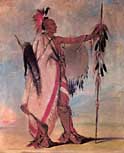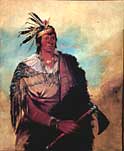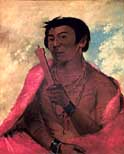
 1. |
 2. |
 3. |
||
| Native American Allies | 1. Tal-lee, an Osage man. enlarge 2. Go-to-kow-pah-a or He Who Stands by Himself, a Wea man enlarge 3. On-saw-kie or The Sac, a Potawatomi man. enlarge (watercolors by George Catlin, 1830-1834) |
|||
The savages of whom I have spoken who come to trade among the Illinois are the Osage and Missouri... They never fail every year to visit them and to bring them the calumet, which is the symbol of peace among all the nations of the south. (Pierre Delliette, 1702)![]()
The Illinois maintained social and economic alliances with many different tribes. In language and culture they were most closely related to the Miami, Piankashaw, and Wea tribes, which lived north of them in the late 1600s and east of them in the 1700s and early 1800s. However, relationships with these tribes were sometimes strained. This was especially true during the French and Indian War (1754-1760), when the Illinois maintained an alliance with the French while the Miami sided with the British.
At the time of European contact, the Michigamea and Chepoussa were the southernmost of the Illinois tribes. They resided on the Black River in what is today northeastern Arkansas. There they maintained a peaceful trading relationship with the Quapaw tribe, which lived on the Arkansas River to the south. However, hostilities broke out in the late 1600s and the Michigamea and Chepoussa withdrew northward to live near the Kaskaskia at the mouth of the Kaskaskia River.
The Illinois were at war with the Osage and Missouri tribes at the time of European contact, but a peaceful trading relationship was established in the late 1600s. As middlemen in an extensive trading network, the Illinois gave metal hatchets, knives, and awls to the Osage and Missouri in exchange for hides and furs that those tribes had obtained in their territories west of the Mississippi River.
In the late 1600s, the Illinois were also at peace with the Potawatomi and Ottawa tribes, which lived to the north in what is today Wisconsin and the upper peninsula of Michigan. From these tribes the Illinois obtained porcupine quills for decorating their moccasins and ornamental head bands.![]()
|
|
Copyright © 2000 Illinois State Museum